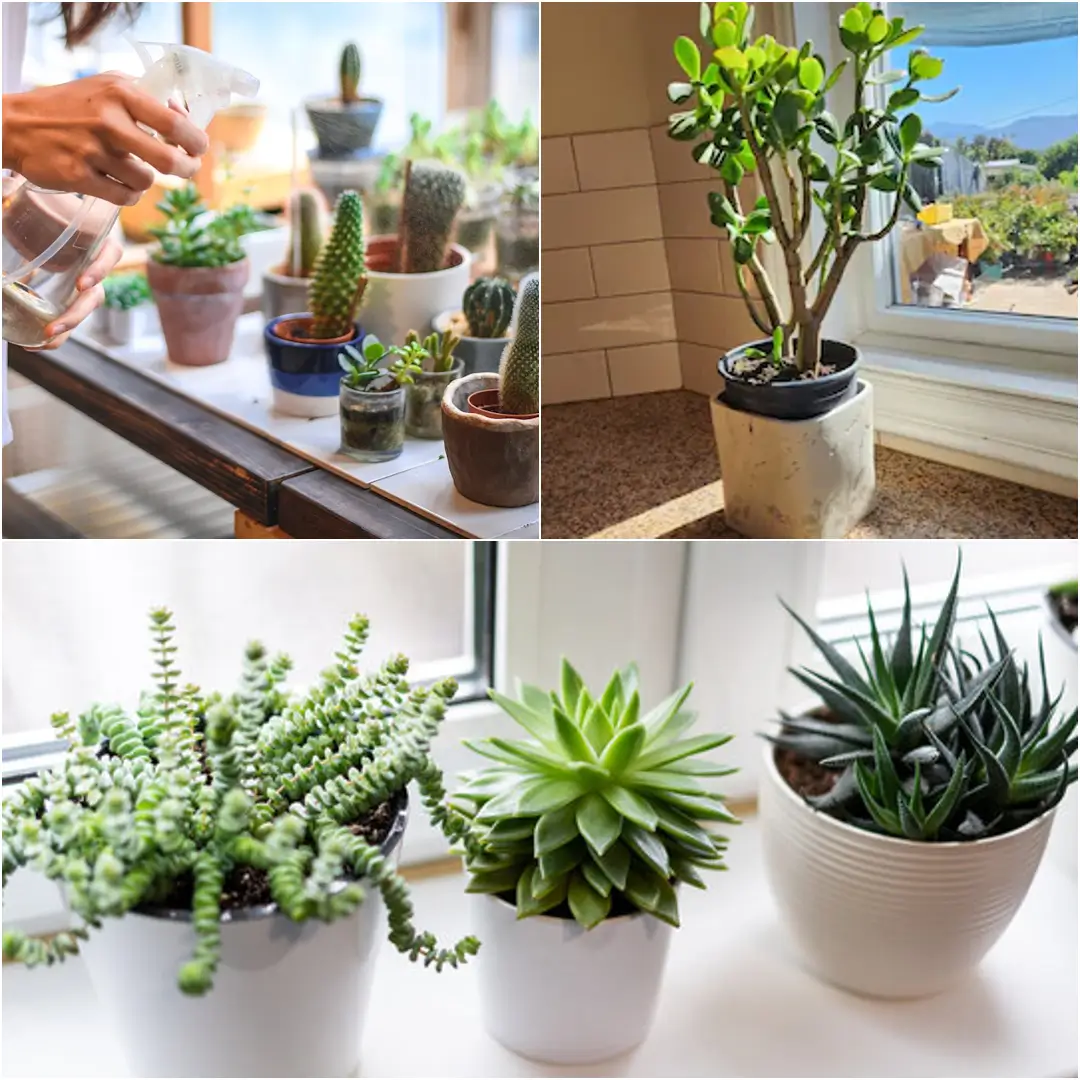Succulents indoors have taken the indoor gardening world by storm, and for good reason! With their plump leaves and vibrant colors, these charming plants not only add a splash of life to any room but also require a level of care that’s refreshingly simple compared to other houseplants. Whether you’re a seasoned green thumb or a newbie, understanding how to care for succulents indoors will help you create a thriving oasis in your home.
Let’s dig deep into the care guidelines for indoor succulents, ensuring you have all the knowledge you need to keep these beauties thriving.
General Characteristics of Indoor Succulents
Succulents are a unique group of houseplants that have thick, juicy stems and/or leaves, allowing them to store water in their tissues. This adaptation makes them remarkably resilient, especially in dry conditions. Here are a few defining characteristics:
- Diverse Family: Succulents belong to various plant families, such as Crassulaceae (stonecrops), Euphorbiaceae (spurge), and Cactaceae (cacti). While all cacti are succulents, not all succulents are cacti. This diversity means you can find succulents in an array of shapes, sizes, and colors, making them collectible and visually appealing.
- Low Maintenance: One of the biggest draws to succulents is their low care requirements. Unlike tropical houseplants that may demand a lot of attention, succulents are perfect for busy individuals or those new to plant care.
- Thriving Conditions: Nearly all succulents thrive under the same environmental conditions. This uniformity allows for beautiful dish gardens where multiple varieties can coexist happily.
Growing Conditions for Indoor Succulents
While succulents are hardy, they still require specific conditions to flourish. Let’s break down these essential factors.
Light Requirements for Succulents
Light is one of the most crucial elements for the health of your succulents. Here’s what you need to know:
- Ideal Light Exposure: Succulents crave at least ten hours of bright, indirect light each day. If you can provide six to eight hours of bright light, that’s a good starting point. Think of it as a spa day for your plants—bright but not too harsh!
- Rotate Regularly: To prevent lopsided growth, make it a habit to rotate your plants. They’re like us; they’ll lean towards the sun!
- Supplemental Lighting: If your indoor space is lacking natural light, consider investing in fluorescent or LED grow lights. These full-spectrum lights mimic sunlight, keeping your succulents happy and healthy.
Soil: The Foundation of Succulent Care
Choosing the right soil is vital for succulents indoors. Regular potting soil tends to retain too much moisture, which can lead to root rot. Here’s how to create the perfect succulent mix:
- Drainage is Key: Succulents require sharp-draining soil that dries quickly. A good mix might include one part organic material (like potting soil or pine bark) and two parts mineral material (such as perlite or coarse sand).
- DIY Mix: Feeling crafty? Combine potting soil, perlite, and coarse sand to create your own succulent potting mix. This blend ensures your plants get the moisture they need without drowning.
Container Choices for Indoor Succulents
Your choice of container can make or break your succulent care. Here are some tips:
- Drainage Holes Are Non-Negotiable: Always choose pots with drainage holes. Even if you think adding gravel at the bottom will do the trick, it won’t replace the need for proper drainage.
- Material Matters: Clay or terracotta pots are fantastic options because they’re porous, allowing moisture to evaporate more quickly than plastic or glazed containers.
- Size Considerations: Small or shallow containers are preferable as they dry out faster. Plus, they add a cute touch to your decor!
Temperature Control for Succulents
Succulents are surprisingly adaptable, but they do appreciate certain temperature ranges:
- Optimal Range: Aim to keep your indoor succulents between 55°F and 75°F. This range mimics their native habitats, where they experience significant temperature shifts from day to night.
- Tolerance Levels: Many succulents can withstand temperatures as low as 45°F and as high as 85°F. However, it’s best to avoid extremes whenever possible.
Humidity and Succulents: A Low-Stress Relationship
Humidity levels typically aren’t a huge concern for succulents indoors, but here’s how to ensure they remain comfortable:
- Low Humidity: Most homes have low humidity, especially in winter, which is perfect for succulents. They thrive in these dry conditions as it helps the soil dry out more quickly.
- Raising Humidity: If you notice your plants beginning to shrivel or develop dry edges, consider using a humidifier or placing a pebble tray filled with water beneath your pots.
Watering: The Heartbeat of Succulent Care
Watering is where many succulent owners go astray. Follow these guidelines to keep your plants hydrated but not waterlogged:
- Wet-Dry Cycle: Establish a wet-dry cycle: water thoroughly until moisture runs out of the drainage holes, then allow the soil to dry out completely before the next watering.
- Frequency: Start with watering every 2 to 3 weeks. However, this may vary depending on environmental factors, so always check the soil moisture first.
- The Touch Test: Stick your finger several inches into the soil. If it’s dry, it’s time to water. If it’s damp, give it a few more days.
Fertilizing Your Succulents
Succulents Indoors aren’t heavy feeders, but giving them a little boost can really help them thrive:
- Minimal Fertilizer: Use a balanced fertilizer during the growing seasons of spring and summer. Apply at half to one-quarter the recommended label rate to avoid overwhelming your plants.
- Timing is Everything: Refrain from fertilizing in winter when succulents are dormant. Think of it as a well-deserved break!
Air Circulation: Let Them Breathe
Good air circulation is crucial for the health of your succulents:
- Spacing is Essential: Space your plants adequately to allow for airflow. When succulents are cramped, they can develop pests and diseases more easily.
- Consider a Fan: If you notice stagnant air, using a small fan can help keep the air moving, which is especially beneficial during humid months.
Propagation: Expanding Your Succulent Family
Succulents are incredibly easy to propagate, making them a fun plant to grow:
- Various Methods: Most succulents can be propagated via offsets, stem cuttings, or leaf cuttings. It’s like giving your plants a chance to have babies!
- Best Time to Propagate: Repotting is an excellent opportunity to propagate. Be gentle when handling your plants to avoid breaking delicate stems or leaves.
Planting & Repotting Succulents
Repotting is an essential part of succulent care but doesn’t have to be frequent:
- Container Size: When repotting, choose a container just big enough for the root system. Larger pots retain more moisture, which succulents despise.
- The Right Soil: Always use well-drained soil when repotting. This ensures your plant can thrive in its new home.
- Gentle Handling: When repotting, carefully lift the plant from its old container and remove excess soil. Treat your succulents like the delicate gems they are!
Common Issues with Succulents
While succulents are relatively low-maintenance, they can encounter a few problems. Here are some common issues to watch out for:
- Pests and Diseases: Succulents have few pest issues, but mealybugs and spider mites can be problematic. Regularly inspect your plants and address any infestations quickly.
- Overwatering: This is perhaps the most common issue. Always ensure your pots have drainage holes and follow the wet-dry watering cycle to prevent root rot.
Caring for succulents indoors can be an incredibly rewarding experience. By understanding their unique needs—light, soil, water, temperature, and more—you can create an environment where they not only survive but thrive. Whether you’re cultivating a single plant or a whole garden of these delightful green companions, remember that each succulent has its own personality and requirements. With a bit of love and attention, you’ll be rewarded with beautiful, resilient plants that brighten your space.
So, what are you waiting for? Dive into the world of succulents and let your indoor garden flourish!
FAQs
How do you keep succulents alive indoors?
To keep succulents alive indoors, ensure they receive adequate light, ideally around 10 hours of bright, indirect sunlight each day. Use well-draining soil and pots with drainage holes to prevent overwatering. Establish a consistent wet-dry watering cycle, allowing the soil to dry completely between waterings. Additionally, provide good air circulation and avoid placing them in overly humid environments.
How often should you water succulents indoors?
You should generally water succulents indoors every 2 to 3 weeks. However, this can vary depending on your home’s temperature and humidity levels. Always check the soil moisture by feeling it a few inches down; water only if it’s completely dry. This helps prevent overwatering, which can lead to root rot.
Do succulents need direct sunlight?
Most succulents thrive in bright, indirect sunlight. While some varieties can tolerate a bit of direct sunlight, too much can scorch their leaves. Aim for about 6 to 8 hours of bright light, and if you notice your succulent stretching or leaning, it may need more light.
Where is the best place to put succulents indoors?
The best place to put succulents indoors is near a south or east-facing window where they can receive ample indirect sunlight. Avoid areas with excessive humidity, like bathrooms, unless the window provides enough light. A well-lit room with good airflow, such as a living room or kitchen, is typically ideal for these hardy plants.


